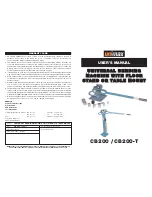
English
13
For more information regarding fuel gauge battery packs, please
call 18004D
e
WALT (18004339258) or visit our website
www.dewalt.com.
Proper Hand Position (Fig. 7)
WARNING:
To reduce the risk of serious personal injury, ALWAYS
use proper hand position as shown.
Cutting
WARNING: To reduce the risk of injury,
• Do not cut short pieces of material that put fingers near
blades. Blade is sharp.
• ALWAYS wear ANSI Z87.1 eye protection (CAN/CSA Z94.3).
• Blade is sharp. Keep hands away from cutting edges and
moving parts. Laceration and amputation can occur.
WARNING: To reduce the risk of injury, always store and
transport the cutter with the blades fully closed.
Before cutting, ensure the blade shoulder bolt and nut are securely
tightened. Refer to figure 4.
1. Push the directional button (E) to the
reverse position and actuate the trigger
switch (D) to open the blades.
2. Insert the workpiece squarely between
the fixed blade (A) and the moving blade
(B) and press the directional button to the
forward position.
CAUTION:
Do not attempt to make angled
cuts as it will damage the workpiece and blade.
3. Ensure the workpiece is straight. Place the
cable to be cut against the fixed blade.
4. Pull the trigger until the workpiece is engaged by the moving
blade.
NOTE:
Workpiece may move slightly during the cut.
FIG. 7
5. When the cut is complete, release the trigger.
CUT CAPACITY
Copper cable:
750MCM
Aluminum cable:
1000MCM
NOTE:
When cutting overhead, always confirm workpiece is secure
before cutting and be sure the excess cable that is cut does not create
a hazard.
NOTICE:
The cable cutter could stall during a cut either as a result of
a depleted battery pack, or as a result of cutting a material too hard or
too large. Should the unit stop during the cut for any reason, put the
control button in reverse position (left side) and pull the trigger switch
to open the cutter jaws and remove the material.
NOTICE:
Do not attempt to cut in the reverse direction. Damage to
the tool could result.
MAINTENANCE
WARNING: To reduce the risk of serious personal injury,
turn tool off and remove the battery pack before making any
adjustments or removing/installing attachments or accessories.
An accidental start-up can cause injury.
Cleaning
WARNING:
Blow dirt and dust out of all air vents with clean, dry air
at least once a week. To minimize the risk of eye injury, always wear
ANSI Z87.1 approved eye protection when performing this.
WARNING:
Never use solvents or other harsh chemicals for cleaning
the non-metallic parts of the tool. These chemicals may weaken the
plastic materials used in these parts. Use a cloth dampened only with
water and mild soap. Never let any liquid get inside the tool; never
immerse any part of the tool into a liquid.
















































